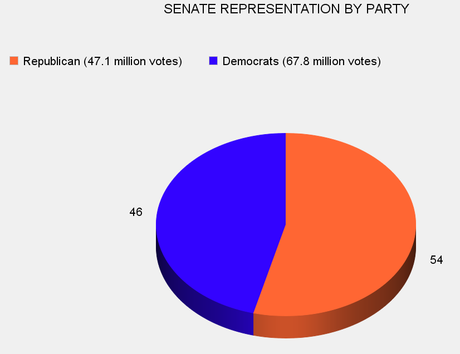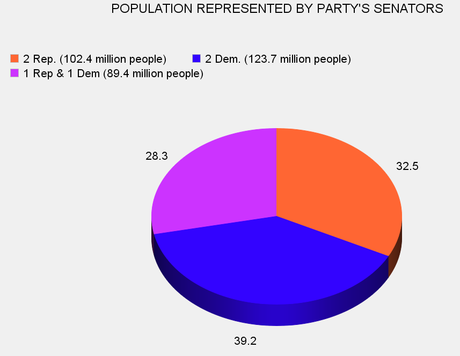

These two charts were made from information gathered by FairVoteBlog.com, and show an interesting quirk in the electoral system of the United States. As the top chart shows, the Republicans will have 54 senators in the new Senate, while the Democrats will have 46 senators. But it took significantly less votes to elect those 54 Republicans (47.1 million votes) than to elect the 46 Democrats (67.8 million votes) -- meaning that Democratic minority received 20.7 million more votes than the Republican majority.
Looking at that, you might expect that the Democrats (even though a minority) actually represents a larger percentage of the population than the Republicans do -- and that is, in fact, true. The second chart shows that the states with two Democratic senators represent 39.2% of the population (123.7 million people), while the states with two Republican senators represent 32.5% of the population (102.4 million people). The states that have 1 Republican and 1 Democratic senator represent the other 28.3% of the population (89.4 million people).
If you consider the states with one senator from each party to be represented by both parties, you get the following figures -- the Republican senators represent 191.8 million Americans (102.4 + 89.4), while the Democratic senators represent 213.1 million Americans (123.7 + 89.4).
This may seem unfair -- that the Democrats got more votes and represent more people, but the Republicans have the most senators. But it comes from how the Constitution was written. As it was being written, the large states wanted representation to be determined by population while the small states wanted all states to have the same number of representatives. Since neither side had enough votes to impose their will on the other, they devised a compromise solution -- two houses of the legislature with one (House) determined by population and the other (Senate) to have equal numbers from all states.
That means that in small population states it only takes a tiny fraction of the votes to be elected to the Senate that it takes in states with a large population. For example, the winning senators in California got about 13 million votes, while the winning senators in Wyoming were elected with only about 300,000 votes.
One might think this would give the Republicans an edge in the next presidential election, but that is not true -- it actually acts as a disadvantage for them. That's because the Democrats do better in states with a large population (and more electoral votes), while the Republicans do better is less populated states (with fewer electoral votes). Texas is the exception to that generality. When you consider states that are solidly in one column or the other, the Democrats will start the 2016 election with more electoral votes in their column, meaning the Republicans will have to win a lot more of the "swing states" to be competitive.
NOTE -- The Republican majority in the House of Representatives also received less votes that the minority Democrats, but that is due to a much different thing -- gerrymandering the districts in states where Republicans have a majority in state legislatures.

